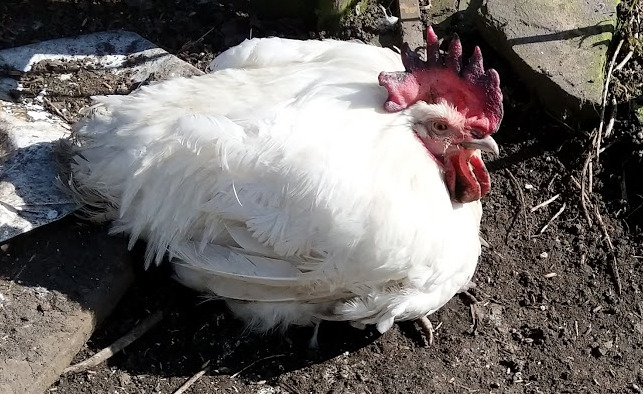Newcastle Disease in chickens

Newcastle disease (ND), sometimes called Virulent Newcastle disease (VND) is a viral disease of many kinds of poultry, wild and cage birds characterised by marked variation in morbidity, mortality, signs, and lesions.
Newcastle disease is a notifiable animal disease and suspected cases must be reported to State or government vets or DEFRA if you live in the UK. There is a compulsory slaughter policy in many parts of the world to help control the disease and vaccination of commercial flocks is required.
Table of Contents
Newcastle is a painful and distressing condition for poultry. Facial swelling, nerve lesions, intestinal and conjunctival haemorrhage can be painful and full or partial paralysis is distressing for chickens.
Newcastle disease is an viral infection of domestic poultry and other bird species with virulent Newcastle disease virus (NDV). It is one the most important diseases of poultry and occurs all over the world. The disease was first reported in 1926 in Java, Indonesia, and Newcastle town (UK). It is also called “Ranikhet” in India.
Newcastle disease is found in all kinds of poultry including chickens, pigeons, and turkeys. The virus belongs to family Paramyxoviridae, subclass Paramyxovirinae, genus Rabula.
The signs and symptoms of Newcastle disease:
As a respiratory disease, symptoms of Newcastle (NCD) tend to appear through breathing difficulties, nasal discharge, murky eyes, and a reduction in egg laying. Sometimes birds can experience twisting in their neck and paralysis in their legs and wings.
The clinical signs and symptoms of Newcastle disease are often different depending on the age of the bird and the strain of virus causing the infection but include:
- The production of the eggs stops within a few days and any eggs that are laid are of low quality and maybe soft-shelled, roughened, or deformed. Production is resumed slowly, or not at all, depending on the stage of low at the time of infection.
- Sneezing and coughing along with dyspnoea or shortness of breath often is marked by gaping and difficulty drawing breath.
- There is severe greenish watery diarrhoea and feather soiling in the vent region.
- Depression, lack of appetite and not indulging in normal behaviours like scratching and dust bathing.
- Swelling and darkening of the tissues about the eyes and face with a sticky ocular and nasal discharge and conjunctivitis, which may bleed.
- It causes weakness in the birds shown by anything from drooping wings to complete paralysis. Some chickens may be prostrate on the floor and unable to move.
- Death in 2-3 days in the flock, morbidity and mortality may be as high as 100%.
- Birds that survive a few days may exhibit signs of Central nervous system (CNS) involvement like tremors, twisting of the head and neck, circling, paresis, paralysis, and terminal clonic spasms.
- In young chicks, broilers may show sudden onset signs of respiratory signs including gasping, sneezing, coughing, rales, nasal and lacrimal discharge and some birds may have swollen heads.
- In broilers particularly there is a sudden onset with marked depression and prostration with birds unable to move. Respiratory signs that include coughing, gasping, nasal discharge, and hoarse chirping.
- Signs of central nervous involvement may accompany or closely follow the respiratory signs with birds being left with the head and neck in abnormal positions, a condition called star gazing. Usually, only a modest number (0-25%) show nervous signs.
- Eventually, there is paralysis, prostration, trampling by pen-mates, and death. Mortality in broilers can be very high, as much as 50% more than other types of chickens.
The incubation period varies from 2-15 days with an average of 5-6 days.
It is because of various pathotypes or serotypes and chick immunity differs with age. In the case of velogenic, there is 5-6 days incubation period.
The virus strains can be differentiated as lentogenic, mesogenic, or velogenic based on a mean death time in chicken embryos.
The mortality rate is from 10 % too 100% depending on the strain of the virus. There are varying strains of this poultry disease, some of which are more lethal than others.
It is a viral disease of birds characterised by mild to severe respiratory or nervous signs and mortality depends on the virus pathogenicity, type, and age of the host. Variation in mortality is high, anything from 10-100% depending upon the virulence of the strain.
Mortality is high in young birds and relatively low in grown-up and adult bids.
The disease is also immunosuppressive making birds susceptible to other infections. Sometimes chickens can survive Newcastle disease. The vaccine for the disease is a strain of the virus that produces no symptoms but makes the bird immune to the more dangerous types of the virus, much like getting cowpox makes you immune to smallpox.
Newcastle is a painful and distressing condition for poultry. Facial swelling, nerve lesions, intestinal and conjunctival haemorrhage can be painful and full or partial paralysis is distressing for chickens.
How is Newcastle disease spread?
Newcastle disease is spread by horizontal transmission is by contact from one animal to another. The virus is present in nasal and ocular discharge and it is excreted in faecal material.
Modes of horizontal transmission of VND:
- Movement of birds - Either flying or the routine shipping of livestock can spread the virus.
- Movement of other animals like rodents and vermin, dogs, cats, and transport of animals.
- Movement of equipment, utensils, poultry products, dead poultry, people (workers). Egg trays are known to be a major source of the spread of ND.
- Airborne spread by wind to nearby farms.
- Ingestion of contaminated feed or water.
- Poor quality or contaminated vaccine.
There is no vertical transmission and Newcastle disease is not spread via eggs.
Diagnosis of Newcastle Disease:
A diagnosis is based on clinical signs. 90% of cases can be confidently said as ND but these symptoms are also present in Avian influenza.
Samples are taken from either the kidney, spleen, intestine, and trachea and homogenised with saline and injected into 10 day old chick embryos. After 2-4 days the embryos will die and the amniotic fluid is collected.
Amniotic fluid is mixed with the Newcastle Disease antiserum and red blood cells, if agglutination (clumping) does not occur, it means the ND virus is present and if agglutination occurs, then it is not the ND virus.
You can also confirm the pathotype of ND virus via using the mean death time or MDT of embryos. How long it takes the embryo to die after injection of the test material will tell you which strain of the virus you are dealing with.
How do you treat Newcastle disease?
There is no cure or specific treatment for Newcastle disease. You have to let the virus run it's course.
If VND is a notifiable disease where you live you birds may need to be destroyed by government vets as some countries have compulsory slaughter policies with Newcastle disease.
Check for secondary bacterial infections and if necessary treat with antibiotics. Any other treatments are palliative to relive symptoms and pain and to make the bird feel better.
Give the birds a normal dry feed and diet. During an outbreak vaccination is not recommended.
Can humans and pets get Newcastle disease?
Humans can catch some strains of Newcastle disease. There is little if any long term risk to humans from ND and the symptoms may include conjunctivitis, a headache and mild fever and last for 3 to 7 days.
Newcastle disease is a notifiable animal disease which means you need to report any suspected cases to your government or state vet (DEFRA in the UK).
People who come in close contact with APMV-1 may build up a temporary, confined eye contamination (conjunctivitis). Human-to-human transmission has not been reported and it is most commonly people who work in slaughter houses that are at risk of getting the virus.
Other pets may suffer as the disease is related to canine distemper.
Both domestic and wild birds can suffer from Newcastle disease and it is found worldwide. Most common in the chickens but other birds that can be affected by ND are Ducks, geese, turkeys, parrots, and wild birds.
You should never eat the eggs or meat from chickens or any poultry infected with Newcastle disease. It is a contagious disease that can infect humans and some other species.
While infection with Newcastle disease in humans is uncommon and usually mild. Humans feel fever, headache, and conjunctivitis for 3-7 days.
So, there is unlikely to be a serious health risk if you consume eggs or meat from infected birds, but it is better to be careful.
Newcastle disease control and prevention:
Prevention and biosecurity measures include:
- Your bird should not have any contact with wild birds.
- Quarantine new arrival for at least 16 days.
- Ensure food and water not contaminated with waste material of other birds.
- Keep equipment and the farm cleaned and use disinfectant.
- Keep rodents and vermin out of the the poultry yard.
- Properly clean and sterilise the returning egg trays.
- Properly maintain buildings.
- Properly wash your hand with proper disinfectant before and after handling the birds.
- Isolation of sick birds and vaccination.
